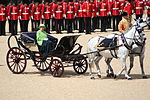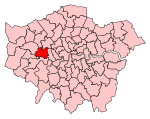Three Wheels Temple
Three Wheels is a Shin Buddhist temple in London, England, founded in 1994. It is the London branch of Shogyōji (正行寺), a temple in Fukuoka Prefecture, Japan, which has affiliations with the larger Higashi Hongan-ji (Ōtani-ha) branch of Shin Buddhism.: 286 The temple was founded by Kemmyō Taira Sato, a former pupil of D. T. Suzuki,: 10 : 291 supporting both the local Japanese diaspora and non-Japanese attendees. The temple is spread across three buildings, with a main building holding the primary altar and two separate buildings used for events and hosting guests, alongside a Zen garden. The Zen garden was designed by John White, art historian and professor at University College London,: 15–16 and it opened in 1997.: 290 Three Wheels conducts daily services, meditation sessions, twice-yearly shokai retreats (a term coined from two characters meaning "to flow" and "to open") involving communal meals, dharma talks, and chanting,: 297 and services such as funerals and weddings. The temple also hosts bi-monthly eza gatherings, which feature dharma talks in English.: 289 The term "eza" means "to meet and sit": 296 and is a distinctive practice within the Shogyōji lineage of temples, compared with wider the Shin Buddhist movement.: 289 Since 1997, Three Wheels has conducted a yearly Annual Ceremony to Pray for World Peace and Reconciliation between British and Japanese War Veterans.: 11
Excerpt from the Wikipedia article Three Wheels Temple (License: CC BY-SA 3.0, Authors).Three Wheels Temple
Carbery Avenue, London Acton (London Borough of Ealing)
Geographical coordinates (GPS) Address Nearby Places Show on map
Geographical coordinates (GPS)
| Latitude | Longitude |
|---|---|
| N 51.50333 ° | E -0.28537 ° |
Address
Carbery Avenue 55
W3 9AB London, Acton (London Borough of Ealing)
England, United Kingdom
Open on Google Maps








